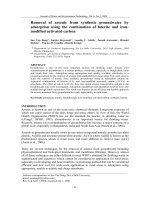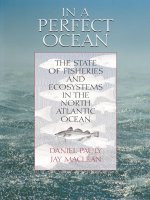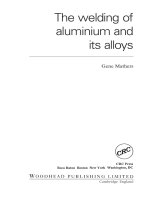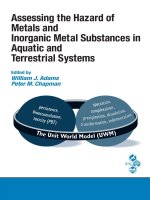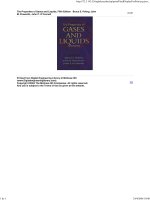Assessing the hazard of metals and inorganic metal substances in aquatic and terrestrial systems
Bạn đang xem bản rút gọn của tài liệu. Xem và tải ngay bản đầy đủ của tài liệu tại đây (3.46 MB, 176 trang )
Half title page
Assessing the Hazard of
Metals and
Inorganic Metal Substances in
Aquatic and
Terrestrial Systems
44400_C000.fm Page i Wednesday, November 15, 2006 9:03 AM
44400_C000.fm Page ii Wednesday, November 15, 2006 9:03 AM
Title Page
Coordinating Editor of SETAC Books
Joseph W. Gorsuch
Gorsuch Environmental Management Services, Inc.
Webster, New York, USA
Proceedings from the Workshop on
Hazard Identification Approach for Metals and
Inorganic Metal Substances
3-8 May 2003
Pensacola Beach, Florida USA
CRC Press is an imprint of the
Taylor & Francis Group, an informa business
Boca Raton London New York
Edited by
William J. Adams
Peter M. Chapman
Assessing the Hazard of
Metals and
Inorganic Metal Substances in
Aquatic and
Terrestrial Systems
44400_C000.fm Page iii Wednesday, November 15, 2006 9:03 AM
Published in collaboration with the Society of Environmental Toxicology and Chemistry (SETAC)
1010 North 12th Avenue, Pensacola, Florida 32501
Telephone: (850) 469-1500 ; Fax: (850) 469-9778; Email:
Web site: www.setac.org
ISBN-10: 1-880611-89-9 (SETAC Press)
ISBN-13: 978-1-880611-89-0 (SETAC Press)
© 2007 by the Society of Environmental Toxicology and Chemistry (SETAC)
SETAC Press is an imprint of the Society of Environmental Toxicology and Chemistry.
No claim to original U.S. Government works
Printed in the United States of America on acid-free paper
10 9 8 7 6 5 4 3 2 1
International Standard Book Number-10: 1-4200-4440-0 (Hardcover)
International Standard Book Number-13: 978-1-4200-4440-9 (Hardcover)
is book contains information obtained from authentic and highly regarded sources. Reprinted material is quoted
with permission, and sources are indicated. A wide variety of references are listed. Reasonable efforts have been
made to publish reliable data and information, but the author and the publisher cannot assume responsibility for
the validity of all materials or for the consequences of their use. Information contained herein does not necessar-
ily reflect the policy or views of the Society of Environmental Toxicology and Chemistry (SETAC). Mention of
commercial or noncommercial products and services does not imply endorsement or affiliation by the author or
SETAC.
e content of this publication does not necessarily reflect the position or policy of the U.S. government or sponsor -
ing organizations and an official endorsement should not be inferred.
No part of this book may be reprinted, reproduced, transmitted, or utilized in any form by any electronic, mechani-
cal, or other means, now known or hereafter invented, including photocopying, microfilming, and recording, or in
any information storage or retrieval system, without written permission from the publishers.
For permission to photocopy or use material electronically from this work, please access www.copyright.com
( or contact the Copyright Clearance Center, Inc. (CCC) 222 Rosewood Drive, Danvers,
MA 01923, (978) 750-8400. CCC is a not-for-profit organization that provides licenses and registration for a variety
of users. For organizations that have been granted a photocopy license by the CCC, a separate system of payment
has been arranged.
Trademark Notice: Product or corporate names may be trademarks or registered trademarks, and are used only for
identification and explanation without intent to infringe.
Library of Congress Cataloging-in-Publication Data
Adams, William J., 1946-
Assessing the hazard of metals and inorganic metal substances in aquatic and terrestrial
systems / William J. Adams and Peter M. Chapman.
p. cm.
Includes bibliographical references and index.
ISBN-13: 978-1-4200-4440-9 (alk. paper)
1. Metals Environmental aspects. 2. Environmental risk assessment. 3.
Metals Toxicology. I. Chapman, Peter M. II. Title.
TD196.M4A33 2006
577.27 dc22
2006022030
Visit the Taylor & Francis Web site at
and the CRC Press Web site at
and the SETAC Web site at
www.setac.org
44400_C000.fm Page iv Wednesday, November 15, 2006 9:03 AM
SETAC Publications
Books published by the Society of Environmental Toxicology and Chemistry
(SETAC) provide in-depth reviews and critical appraisals on scientific subjects
relevant to understanding the impacts of chemicals and technology on the environ-
ment. The books explore topics reviewed and recommended by the Publications
Advisory Council and approved by the SETAC North America Board of Directors,
SETAC Europe Council, or SETAC World Council for their importance, timeliness,
and contribution to multidisciplinary approaches to solving environmental problems.
The diversity and breadth of subjects covered in the publications reflect the wide
range of disciplines encompassed by environmental toxicology, environmental chem-
istry, hazard and risk assessment, and life-cycle assessment. SETAC books attempt
to present the reader with authoritative coverage of the literature, as well as para-
digms, methodologies, and controversies; research needs; and new developments
specific to the featured topics. The books are generally peer reviewed for SETAC
by acknowledged experts.
SETAC publications, which include Technical Issue Papers (TIPs), workshop
summaries, a newsletter (
SETAC Globe
), and journals (
Environmental Toxicology
and Chemistry
and
Integrated Environmental Assessment and Management
), are
useful to environmental scientists in research, research management, chemical
manufacturing and regulation, risk assessment, life-cycle assessment, and educa-
tion, as well as to students considering or preparing for careers in these areas. The
publications provide information for keeping abreast of recent developments in
familiar subject areas and for rapid introduction to principles and approaches in
new subject areas.
44400_C000.fm Page v Wednesday, November 15, 2006 9:03 AM
44400_C000.fm Page vi Wednesday, November 15, 2006 9:03 AM
Table of Contents
Acknowledgments xi
Editors xiii
Workshop Participants xv
Chapter 1
A Pellston Workshop on Metals Hazard Assessment 1
William J. Adams and Peter M. Chapman
1.1 Introduction to the Workshop 1
1.2 Hazard Identification, Classification, and Assessment 2
1.3 Workshop Purpose and Goals 4
References 4
Chapter 2
Executive Summary 7
William J. Adams and Peter M. Chapman
2.1 Introduction 7
2.2 Persistence 7
2.3 Bioaccumulation 8
2.4 Toxicity 8
2.5 Terrestrial Environment 9
2.6 Conclusion 10
Chapter 3
Integrated Approach for Hazard Assessment of Metals and
Inorganic Metal Substances: The Unit World Model Approach 11
Adam Peters, William J. Adams, Miriam L. Diamond, William Davison,
Dominic M. Di Toro, Patrick J. Doyle, Donald Mackay, Jerome Nriagu,
Carol Ptacek, James M. Skeaff, Edward Tipping, and Hugo Waeterschoot
3.1 Introduction 11
3.1.1 Background 11
3.1.2 A Unifying Model 13
3.2 The Unit World Model (UWM) 14
3.3 Hazard Assessment Framework for a Generic Environment 16
3.3.1 Generalized Model Framework 16
3.3.2 Water Column/Sediment Model 17
3.3.3 Soil Model 21
3.3.4 Key Processes 23
3.4 Source Term 23
3.4.1 Natural Occurrence of Metals 24
44400_C000.fm Page vii Wednesday, November 15, 2006 9:03 AM
3.4.2 Determining the Input Term 24
3.4.2.1 Measuring Tool for the Aquatic Compartment 26
3.4.2.2 Measuring Tool for the Soil Compartment 26
3.4.3 Combinations of Commercial Compounds 28
3.4.4 Generic Data Needs 28
3.5 Application of the UWM 28
3.5.1 Application to Classification 30
3.5.2 Application to Ranking 30
3.5.3 Application to Screening Assessment 31
3.5.4 Distribution of the Mass Input into Compartments for
Different Assessment Levels 31
3.5.5 Precautionary Approach 31
3.6 Illustrations of Hazard Assessments 32
3.6.1 Example 1: The Generic Environment (Unit World) 32
3.6.1.1 Organic Compounds 34
3.6.1.2 2 Metals 41
3.6.2 Example 2: A Simple Approach for Soils 41
3.6.2.1 Defining a Unit World Soil 41
3.6.2.2 Scoping Calculations 45
3.6.2.3 Application 46
3.6.3 Example 3: The Water Column/Sediment Model 46
3.7 Steps Required to Proceed from a Prototype to a Workable Model 48
3.7.1 Implementation 48
3.7.2 UWM Evaluation and Validation 49
Acknowledgments 51
References 51
Chapter 4
Bioaccumulation: Hazard Identification of Metals and
Inorganic Metal Substances 55
Christian E. Schlekat, James C. McGeer, Ronny Blust, Uwe Borgmann,
Kevin V. Brix, Nicolas Bury, Yves Couillard, Robert L. Dwyer, Samuel N. Luoma,
Steve Robertson, Keith G. Sappington, Ilse Schoeters, and Dick T.H.M. Sijm
4.1 Introduction 55
4.2 Regulatory Objectives of Bioaccumulation in Hazard Assessment 56
4.2.1 European Union (EU) 56
4.2.2 United States 56
4.2.3 Canada 57
4.3 Scientific Basis of Metal Bioaccumulation: Current State of
Understanding 57
4.3.1 Mechanisms of Metal Uptake 57
4.3.2 Gill vs. Gut Environments 58
4.3.3 Chemical Speciation and Biological Availability 59
4.3.4 Bioaccumulation and Toxicity 60
4.3.5 Metal Exposure Concentrations and Accumulation 62
44400_C000.fm Page viii Wednesday, November 15, 2006 9:03 AM
4.4 Limitations of Current Approach to Bioconcentration Factors (BCFs)
and Bioaccumulation Factors (BAFs) 63
4.4.1 Metal Bioaccumulation, Toxicity, and Trophic Transfer 63
4.4.1.1 Inverse Relationships 63
4.4.1.2 Bioaccumulation in Relation to Chronic Toxicity 64
4.4.1.3 Trophic Transfer 65
4.4.2 Implication 65
4.5 Further Guidance on Bioaccumulation 65
4.5.1 Biodynamic Models 65
4.5.2 Application of BCF and BAF Data 66
4.5.2.1 Linking BCF with Chronic Lethality 66
4.5.2.2 Accounting for Accumulation from Background
Concentrations 71
4.5.2.3 Calculating BCF and BAF Values over a Limited
Range of Concentrations 71
4.5.2.4 Bioaccumulation in Relation to Dietary Toxicity 72
4.6 Integration of Chronic Thresholds and Trophic Transfer into the Unit
World Model 72
4.6.1 Introduction 72
4.6.2 Trophic Transfer Models 73
4.6.2.1 Conceptual Framework 73
4.6.2.2 Biodynamic Bioaccumulation Models 75
4.6.2.3 Use of Model Outputs 78
4.6.3 Uncertainties 79
4.6.3.1 Bioaccumulation Models 79
4.6.3.2 Toxicity Reference Values (TRVs) 81
4.6.3.3 Protectiveness of Environmental Quality Standards 81
4.7 Conclusions 82
References 83
Chapter 5
Aquatic Toxicity for Hazard Identification of Metals and
Inorganic Metal Substances 89
Andrew S. Green, Peter M. Chapman, Herbert E. Allen, Peter G.C. Campbell,
Rick D. Cardwell, Karel De Schamphelaere, Katrien M. Delbeke, David R. Mount,
and William A. Stubblefield
5.1 Introduction 89
5.2 Data Acceptability 90
5.2.1 Data Evaluation and Species Selection Criteria 90
5.2.2 Culture and Test Conditions 92
5.2.2.1 Background and Essentiality 92
5.2.2.2 Other Relevant Test System Characteristics 94
5.2.2.3 Algal Tests 95
5.3 Sediment Effect Thresholds 95
5.4 Dietary Exposure 97
44400_C000.fm Page ix Wednesday, November 15, 2006 9:03 AM
5.5 Bioavailability 98
5.5.1 Speciation 98
5.5.2 Biotic Ligand Model (BLM) 99
5.5.3 Algae 99
5.5.4 BLM Data Gaps and Future Directions 101
5.5.5 Taking Bioavailability into Account 101
5.6 Integrated Approach for Risk/Hazard Assessments Using Toxicity 103
5.6.1 Approach 103
5.6.2 Examples 105
5.7 Conclusions and Recommendations 106
Acknowledgment 107
References 107
Chapter 6
Hazard Assessment of Inorganic Metals and Metal Substances
in Terrestrial Systems 113
Erik Smolders, Steve McGrath, Anne Fairbrother, Beverley A. Hale, Enzo Lombi,
Michael McLaughlin, Michiel Rutgers, and Leana Van der Vliet
6.1 Foreword 113
6.2 Introduction 113
6.3 Persistence of Metals in Soil 114
6.3.1 Residence Time of Metals in Soil 114
6.3.2 Critical Loads of Metals 114
6.3.3 Aging of Metals in Soil 115
6.3.4 Transformation of Sparingly Soluble Compounds 118
6.4 Bioaccumulation of Metals in the Terrestrial Food Chain 119
6.4.1 Defining Bioaccumulation Factor (BAF) and Bioconcentration
Factor (BCF) in the Terrestrial Environment 119
6.4.2 Measuring BAF/BCFs — The Denominator 120
6.4.3 Interpreting BAF/BCFs 121
6.4.4 Trophic Transfer Factors 121
6.4.5 Trophic Transfer of Metals 122
6.4.6 Proposed Approach for Incorporation of BAF into Hazard
Assessment 122
6.5 Ranking Metal Toxicity in Terrestrial Systems 123
6.6 Conclusions and Recommendations 129
References 130
Appendix A:
A Unit World Model for Hazard Assessment of Organics
and Metals 135
A.1 The Aquivalence Approach 135
A.2 Unit World Parameters 136
A.3 Mass Balance Equations 137
References 140
Index
141
44400_C000.fm Page x Wednesday, November 15, 2006 9:03 AM
Acknowledgments
This book presents the proceedings of a Pellston Workshop convened by the Society
of Environmental Toxicology and Chemistry (SETAC) in Pensacola, Florida, in May
2003. The 47 scientists, managers, and policymakers involved in this workshop
represented seven countries. We thank all participants for their contributions, both
in the workshop and in subsequent discussions resulting in this book.
The workshop and this book were made possible by the generous support of the
following organizations (in alphabetical order):
• Center for the Study of Metals in the Environment (CSME)
• Environment Canada
• Eurometaux
• International Copper Association
• International Lead Zinc Research Organization
• Kennecott Utah Copper Corporation
• Kodak
• Natural Resources Canada
• Nickel Producers Environmental Research Association (NiPERA)
• Rio Tinto
• U.S. Environmental Protection Agency (Office of Research and Development)
The workshop would also not have been possible without the very capable
management and excellent guidance provided by Greg Schiefer, Linda Longsworth,
and Mimi Meredith, and the support of SETAC Executive Director Rodney Parrish.
In particular, the efforts of Mimi Meredith in the production of this book are
gratefully acknowledged.
William J. Adams
Peter M. Chapman
44400_C000.fm Page xi Wednesday, November 15, 2006 9:03 AM
44400_C000.fm Page xii Wednesday, November 15, 2006 9:03 AM
Editors
William J. Adams, Ph.D.
is a Principal Environmental Scientist and General Man-
ager for Rio Tinto, Salt Lake City, Utah. He was previously the Director of Environ-
mental Science for 6 years at Kennecott Utah Copper, Vice President of ABC Lab-
oratories for 5 years, and Science Fellow at Monsanto Company for 14 years. His
research interests include developing ecotoxicology risk assessment methods for
metals, site-specific methodologies for water quality criteria for metals, and devel-
opment of an approach for hazard assessment of metals. Dr. Adams has published
several papers on methods for assessing sediments and was instrumental in developing
the science supporting equilibrium partitioning theory (EqP) for nonpolar organic
substances. He has also published in the area of water quality assessments. He was
a member of the U.S. Environmental Protection Agency (EPA) Science Advisory
Board (SAB) for 10 years and has served on several other national committees.
Peter M. Chapman
is a Principal and Senior Environmental Scientist with Golder
Associates in North Vancouver, British Columbia, Canada. He has been an active
researcher for almost 30 years in the fields of aquatic ecology, ecotoxicology, and
environmental risk assessment, with a particular focus on metals and metalloids. He
has published more than 140 articles in international, peer-reviewed scientific jour-
nals, and in book chapters. He is Senior Editor of the international, peer-reviewed
journal
Human and Ecological Risk Assessment
, a member of the editorial board of
two other international peer-reviewed journals, and edits a highly popular series of
scientific “Learned Discourses” in the
SETAC Globe
. In 1996 he received an award
from the EPA for resolving environmental issues in Port Valdez, Alaska. In 2001,
the Society of Environmental Toxicology and Chemistry awarded him their highest
award for lifetime achievement and outstanding contributions to the environmental
sciences: The Founders Award.
44400_C000.fm Page xiii Wednesday, November 15, 2006 9:03 AM
44400_C000.fm Page xiv Wednesday, November 15, 2006 9:03 AM
Workshop Participants*
Steering Committee Member (SCM)
Workshop Chair (WC)
WORKGROUP 1: PERSISTENCE
William J. Adams (WC) (SCM)
Rio Tinto
Murray, Utah
William Davison
Lancaster University
Lancaster, United Kingdom
Dominic M. Di Toro
Hydroqual
Englewood, New Jersey
Miriam L. Diamond
University of Toronto
Toronto, Ontario, Canada
Patrick J. Doyle (SCM)
Environment Canada
Hull, Ontario, Canada
Samuel Luoma
U.S. Geological Survey
Menlo Park, California
Donald Mackay
Trent University
Peterborough, Ontario, Canada
Jerome Nriagu
University of Michigan
Ann Arbor, Michigan
Johanna Peltola-Thies
Federal Environmental Agency
Berlin, Germany
Adam Peters (Rapporteur)
Environment Agency
Wallingford, United Kingdom
Carol Ptacek
University of Waterloo
Waterloo, Ontario, Canada
James M. Skeaff
Natural Resources Canada
Ottawa, Ontario, Canada
Edward Tipping
Centre for Ecology and Hydrology
Cumbria, United Kingdom
Hugo Waeterschoot
Eurometaux
Brussels, Belgium
John Westall (Chair) (SCM)
Oregon State University
Corvallis, Oregon
William Wood (SCM)
U.S. Environmental Protection Agency
Washington, D.C.
* Affiliations were current at the time of the workshop.
44400_C000.fm Page xv Wednesday, November 15, 2006 9:03 AM
WORKGROUP 2: BIOACCUMULATION
Ronny Blust
University of Antwerp
Antwerp, Belgium
Uwe Borgmann
Environment Canada
Burlington, Ontario, Canada
Kevin Brix
EcoTox
Newport, Oregon
Nicolas Bury
King’s College
London, United Kingdom
Yves Couillard
Environment Canada
Hull, Quebec, Canada
Robert L. Dwyer
International Copper Association
New York, New York
Samuel N. Luoma
U.S. Geological Survey
Menlo Park, California
James C. McGeer (Rapporteur)
Natural Resources Canada
Ottawa, Ontario, Canada
Steve Robertson (SCM)
Environment Agency
Wallingford, United Kingdom
Keith G. Sappington
U.S. Environmental Protection Agency
Washington, D.C.
Christian Schlekat (Chair)
U.S. Borax
Valencia, California
Ilse Schoeters (SCM)
European Copper Institute
Brussels, Belgium
Dick T.H.M. Sijm
National Institute for Public Health and
the Environment (RIVM)
Bilthoven, The Netherlands
WORKGROUP 3: TOXICITY
Herbert E. Allen
University of Delaware
Newark, Delaware
Peter G.C. Campbell (SCM)
Université du Québec
Ste. Foy, Quebec, Canada
Richard D. Cardwell
Parametrix
Corvallis, Oregon
Peter M. Chapman (Rapporteur)
(SCM)
EVS Consultants
North Vancouver, British Columbia,
Canada
Amy Crook
Center for Science in Public
Participation/Environmental Mining
Council
Victoria, British Columbia, Canada
44400_C000.fm Page xvi Wednesday, November 15, 2006 9:03 AM
Karel De Schamphelaere
University of Ghent
Ghent, Belgium
Katrien Delbeke
European Copper Institute
Brussels, Belgium
Andrew S. Green (Chair)
International Lead Zinc Research
Organization
Research Triangle Park, North Carolina
David R. Mount
U.S. Environmental Protection Agency
Duluth, Minnesota
William A. Stubblefield
Parametrix
Corvallis, Oregon
WORKGROUP 4: TERRESTRIAL
Anne Fairbrother
U.S. Environmental Protection Agency
Corvallis, Oregon
Beverly A. Hale
University of Guelph
Guelph, Ontario, Canada
Enzo Lombi
Commonwealth Scientific and
Industrial Research Organization
(CSIRO) Land and Water
Adelaide, Australia
Steve McGrath
IACR-Rothamsted
Herts, United Kingdom
Michael McLaughlin
Commonwealth Scientific and
Industrial Research Organization
(CSIRO) Land and Water
Adelaide, Australia
Michiel Rutgers
National Institute for Public Health and
the Environment (RIVM)
Bilthoven, The Netherlands
Erik Smolders (Chair) (SCM)
K.U. Leuven
Heverlee, Leuven, Belgium
Leana Van der Vliet
Environment Canada
Ottawa, Ontario, Canada
44400_C000.fm Page xvii Wednesday, November 15, 2006 9:03 AM
44400_C000.fm Page xviii Wednesday, November 15, 2006 9:03 AM
1
1
A Pellston Workshop
on Metals Hazard
Assessment
William J. Adams and Peter M. Chapman
1.1 INTRODUCTION TO THE WORKSHOP
This book is the result of discussions that took place at the Pellston Workshop on
Assessing the Hazard of Metals and Inorganic Metal Substances in Aquatic and
Terrestrial Systems. The workshop, sponsored by the Society of Environmental
Toxicology and Chemistry (SETAC), was held 3–8 May, 2003, in Pensacola, FL.
The workshop built upon the findings of a previous SETAC workshop, which
provided an in-depth discussion of the potential to assess bioavailability of metals
to fish and invertebrates (Bergman and Dorward-King 1996) and which led to the
development of the Biotic Ligand Model (BLM) (Di Toro et al. 2001, 2005).
The purpose of the workshop was to allow for a focused discussion regarding
the fate and effects of metals in the environment (the focus was on inorganic
substances; however, where appropriate, organometallic substances were also con-
sidered) and incorporating important advances in the state of knowledge that had
occurred in the intervening 7 years. Specifically, this workshop allowed for a forum
for further discussions among scientists, environmental regulators, and environmen-
tal managers, on the utility of persistence, bioaccumulation, and toxicity (PBT) for
hazard identification and classification procedures for metals and inorganic metal
substances.
The workshop brought together a multidisciplinary and international group of
47 scientists, managers, and policymakers from Australia, Belgium, Canada, Ger-
many, The Netherlands, the United Kingdom, and the United States for 6 days of
discussions on various means to assess the environmental hazard posed by metals
and inorganic metal substances. Participants included representatives from regulatory
and nonregulatory government agencies, academia, industry, environmental groups,
and consulting firms involved in assessment, management, and basic research on
metals and metal substances.
During the first day of the workshop, presentations were given on the appli-
cation of PBT criteria in the different regulatory arenas in Canada, Europe, and
the United States. Additional presentations highlighted the state of the science
regarding the interpretation of PBT for metals. These presentations provided the
44400_C001.fm Page 1 Wednesday, November 15, 2006 9:04 AM
2
Assessing the Hazard of Metals and Inorganic Metal Substances
basis for subsequent plenary and workgroup discussions. Participants were
assigned to 4 different workgroups as follows:
1. Persistence — reviewing the scientific underpinnings of the use of
persistence in hazard evaluation and of persistence measures as applied
to metals, including the potential to use bioavailability measures in
aquatic systems.
2. Bioaccumulation — reviewing the soundness of current uses of bioaccu-
mulation in hazard evaluation of metals in aquatic species and aquatic-
linked food chains.
3. Toxicity — reviewing toxicity procedures used to assess the hazard of
metals as used within PBT approaches.
4. Terrestrial systems — evaluating current uses of PBT measures for metals
in terrestrial ecosystems, with a view to improving the approach or iden-
tifying an alternative methodology.
In each of these discussions, participants were urged to seek consensus, where
possible, on specific technical issues of concern for assessing the hazard of metals
and metal substances, and to identify recommendations for future research that could
lead to improvements in the existing methods available. Chapter 3 through Chapter
6 in this book provide a synopsis of the discussions and conclusions from each of
the workgroups; an overall executive summary is provided in Chapter 2.
This book provides the basis for substantive improvements to the current model
for the hazard assessment of metals and metal substances. It is our hope that this
book will not only advance the science, but will also serve as the basis for further
discussions and advances in the foreseeable future.
1.2 HAZARD IDENTIFICATION, CLASSIFICATION,
AND ASSESSMENT
Hazard identification and classification procedures currently used in many countries
are based on PBT measurements. Procedures for aquatic hazard identification or
classification of organic and inorganic substances have been harmonized by the
Organisation for Economic Cooperation and Development (OECD 2001) for the
purpose of classifying market-place substances in terms of their potential hazard.
PBT criteria are further used within the regulatory context to rank and identify
substances of concern. In the United States, PBT criteria have been used to identify
substances of concern for waste minimization, emissions reporting, and for the
identification of substances for stricter regulations (air, water, and solid waste). In
Canada, a PBT-type approach is used for categorizing substances on the Domestic
Substances List (DSL) to determine if a screening assessment is required. Depend-
ing upon the assessment findings, actions to reduce exposure may be taken. In the
European Union (EU), in the framework of the New Chemicals Policy, discussions
are ongoing on whether to use PBT criteria to identify substances of very high
concern, which will have to be given use-specific permission before they can be
44400_C001.fm Page 2 Wednesday, November 15, 2006 9:04 AM
A Pellston Workshop on Metals Hazard Assessment
3
employed in particular uses. In addition, the EU New Chemicals Policy (REACH:
Registration, Evaluation, Authorization, and Restriction of Chemicals) will neces-
sitate authorization for use of substances classified as PBT and vPvB (very persis-
tent and very bioaccumulative).
Materials used in manufacturing and commerce may be hazardous to the
environment.
Hazard
is defined as a measure of the inherent (intrinsic) capacity
of a substance to cause an adverse response in a living organism (OECD 1995).
Organisms will be placed at possible risk if the substance enters the environment,
with the degree (probability) of risk related to the hazardous nature of the substance
and the amount of exposure that occurs. Therefore, substances that are very
hazardous have a greater likelihood of causing environmental injury in the case
of spills or other accidents than those that are less hazardous. Hazard assessment
is differentiated from risk assessment in that it does not quantitatively evaluate
exposure and deals with inherent properties, not probabilities. Measures of per-
sistence, such as biodegradation and hydrolysis, may be viewed as surrogates of
biota exposure to different substances. There have been several primary uses of
hazard information:
• environmental hazard classification of substances;
• ranking and/or selection of priority substances;
• Selection of contaminated sites for further evaluation;
• derivation of water, soil, and sediment quality guidelines or criteria for
individual substances; and
• ecological risk assessments, both site-specific (i.e., local) and generic (i.e.,
regional), in conjunction with appropriate exposure data.
A more detailed discussion on hazard assessment of metals is presented in Adams
et al. (2000) and Fairbrother et al. (2002).
The scientific community and many regulators recognize that there are significant
challenges associated with the application of traditional PBT hazard evaluation tools
for inorganic metals and metal substances (collectively termed metals) and that
additional tools and techniques may be needed for the proper hazard identification
and risk assessment of metals. Further, it is understood that hazard (and risk)
assessment must be performed in such a way as to ensure that all substances are
evaluated equally and fairly while ensuring that both the environment and human
health are protected.
Key issues associated with the application of PBT concepts to metals are as
follows (full details are provided in the respective chapters):
Persistence (Chapter 3):
Traditional degradation mechanisms used for
organic substances to evaluate persistence (or the converse, biodegradation)
of metals have been criticized as inappropriate (Canada/European Union
1996). A key question remains as to whether alternative mechanisms and
measurements are needed for metals and, if so, which of these are accept-
able and under what conditions do they apply? Although it is recognized
44400_C001.fm Page 3 Wednesday, November 15, 2006 9:04 AM
4
Assessing the Hazard of Metals and Inorganic Metal Substances
that metals are conserved, the form and availability of the metal can change
and are different for each metal element.
Bioaccumulation (Chapter 4):
Unlike organic substances, bioaccumulation
potential of metals cannot be estimated using log octanol–water partition
coefficients (Log
K
ow
). Bioconcentration and bioaccumulation factors
(BCFs and BAFs) are inversely related to exposure concentration and are
not reliable predictors of chronic toxicity or food chain accumulation for
most aquatic organisms and most metals (Chapman and Wang 2000). The
inverse relationship between exposure concentration and BCF results in
organisms from the cleanest environments (i.e., background) having the
largest BCF or BAF values. This result is counterintuitive to the use of
BCF and log
K
ow
as originally derived for organic substances (McGeer et
al. 2003). Many organisms appear to regulate metal accumulation to some
extent, especially for essential metals.
Toxicity (Chapter 5):
Metals are generally not readily soluble. Toxicity test
results based on soluble salts may overestimate the bioavailability and the
potential for toxicity for many substances, especially for the massive metals
and insoluble sulfide and metal oxide forms.
1.3 WORKSHOP PURPOSE AND GOALS
The purpose of this workshop was to identify limitations in the use of PBT for
hazard assessment of metals and propose improvements or alternatives. A series of
questions were posed for each working group (WG) as a means to initiate discussion.
However, the WGs were not required to answer each question; rather, they were
presented with the following challenge: to review the science underpinning the use
and measurement of PBT for hazard identification of metals in the aquatic environ-
ment, propose alternatives or improvements, and identify a hazard assessment
approach for terrestrial ecosystems. It was recognized that the development of an
integrated approach for hazard assessment would present the best outcome, provided
such an approach could be developed. In fact, such an approach, termed the unit
world model (UWM) was developed and is presented in detail in Chapter 3.
REFERENCES
Adams WJ, Conard B, Ethier G, Brix KV, Paquin PR, DiToro DM. 2000. The challenges of
hazard identification and classification of insoluble metals and metal substances for
the aquatic environment. Human Ecol Risk Assess 6:1019–1038.
Bergman HL, Dorward-King EJ. 1996. Reassessment of metals criteria for aquatic life pro-
tection. Pensacola, FL: SETAC Press.
Canada/European Union. 1996. Technical Workshop on biodegradation/persistence and bio-
accumulation/biomagnification of metals and metal compounds. Brussels, Belgium.
Chapman PM, Wang F. 2000. Issues in ecological risk assessment of inorganic metals and
metalloids. Human Ecol Risk Assess 6:965–988.
44400_C001.fm Page 4 Wednesday, November 15, 2006 9:04 AM
A Pellston Workshop on Metals Hazard Assessment
5
Di Toro DM, Allen HE, Bergman H, Meyer JS, Paquin PR, Santore CS. 2001. Biotic ligand
model of the acute toxicity of metals. 1. Technical basis. Environ Toxicol Chem
20:2383–2396.
Di Toro DM, McGrath JA, Hansen DJ, Berry WJ, Paquin PR, Mathew R, Wu KB, Santore
RC. 2005. Predicting sediment metal toxicity using a sediment Biotic Ligand Model:
methodology and initial application. Environ Toxicol Chem 24:2410–2427.
Fairbrother A, Glazebrook PW, van Straalen NM, Tarazona JV (eds). 2002. Test methods for
hazard determination of metals and sparingly soluble metal compounds in soils.
Pensacola, FL: SETAC Press.
McGeer JC, Brix KV, Skeaff JM, DeForest DK, Brigham SI, Adams WJ, Green A. 2003.
Inverse relationship between bioconcentration factor and exposure concentration for
metals: implications for hazard assessment of metals in the aquatic environment.
Environ Toxicol Chem 22:1017–1037.
OECD (Organisation for Economic Cooperation and Development). 1995. Test methods for
hazard and risk determination of metals and inorganic metal compounds. Paris,
France: OECD.
OECD (Organisation for Economic Cooperation and Development). 2001. harmonized inte-
grated hazard classification system for human health and environmental effects of
chemical substances. Available from: />
44400_C001.fm Page 5 Wednesday, November 15, 2006 9:04 AM
44400_C001.fm Page 6 Wednesday, November 15, 2006 9:04 AM
